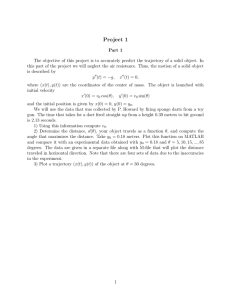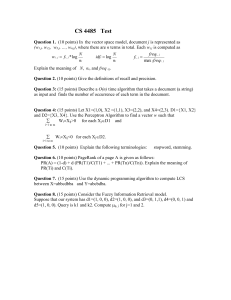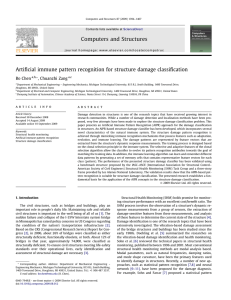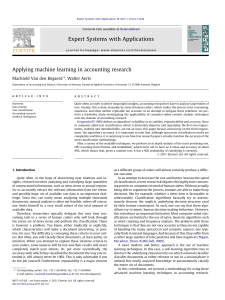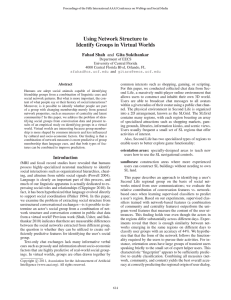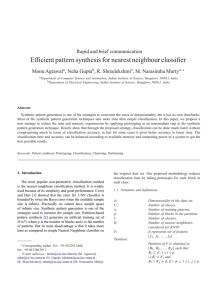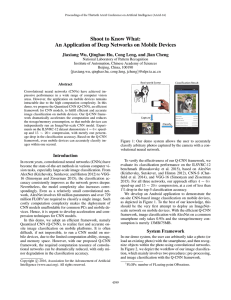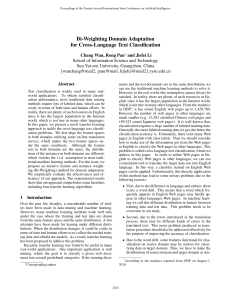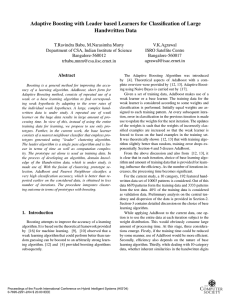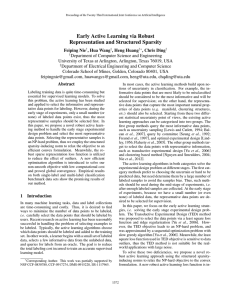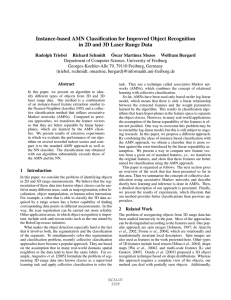MIT Department of Brain and Cognitive Sciences Instructor: Professor Sebastian Seung
advertisement
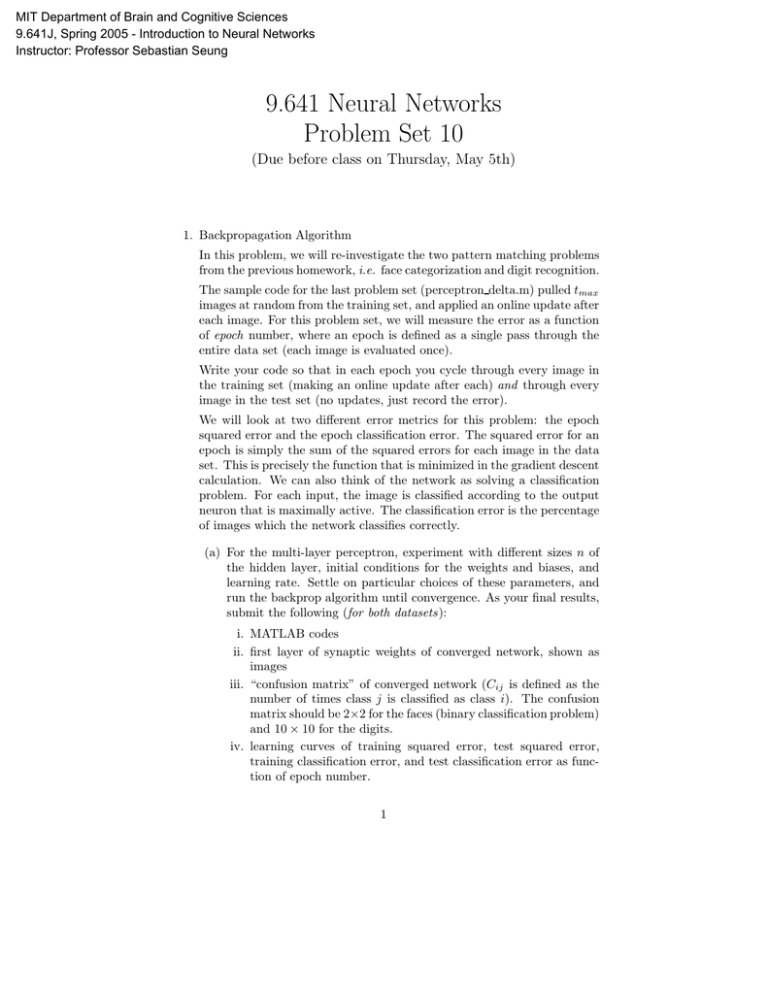
MIT Department of Brain and Cognitive Sciences
9.641J, Spring 2005 - Introduction to Neural Networks
Instructor: Professor Sebastian Seung
9.641 Neural Networks
Problem Set 10
(Due before class on Thursday, May 5th)
1. Backpropagation Algorithm
In this problem, we will re-investigate the two pattern matching problems
from the previous homework, i.e. face categorization and digit recognition.
The sample code for the last problem set (perceptron delta.m) pulled tmax
images at random from the training set, and applied an online update after
each image. For this problem set, we will measure the error as a function
of epoch number, where an epoch is defined as a single pass through the
entire data set (each image is evaluated once).
Write your code so that in each epoch you cycle through every image in
the training set (making an online update after each) and through every
image in the test set (no updates, just record the error).
We will look at two different error metrics for this problem: the epoch
squared error and the epoch classification error. The squared error for an
epoch is simply the sum of the squared errors for each image in the data
set. This is precisely the function that is minimized in the gradient descent
calculation. We can also think of the network as solving a classification
problem. For each input, the image is classified according to the output
neuron that is maximally active. The classification error is the percentage
of images which the network classifies correctly.
(a) For the multi-layer perceptron, experiment with different sizes n of
the hidden layer, initial conditions for the weights and biases, and
learning rate. Settle on particular choices of these parameters, and
run the backprop algorithm until convergence. As your final results,
submit the following (for both datasets):
i. MATLAB codes
ii. first layer of synaptic weights of converged network, shown as
images
iii. “confusion matrix” of converged network (Cij is defined as the
number of times class j is classified as class i). The confusion
matrix should be 2×2 for the faces (binary classification problem)
and 10 × 10 for the digits.
iv. learning curves of training squared error, test squared error,
training classification error, and test classification error as function of epoch number.
1
For your best parameters how does the squared error evolve over time
for the training set? What about bad parameters? What about the
test set? How do the two curves compare?
What about the classification error? Is the squared error a good
predictor of the classification error?
(b) Run a single-layer perceptron (modify the perceptron delta.m code
from last time) on the two datasets and submit the items (i) through
(iiii). How does the multi-layer perceptron compares with the single
layer?
2. Limit Cycle Learning.
The classical test problem for trajectory learning in neural networks is the
circle problem. For this problem we will use a circular desired trajectory
d(t) with a center at [0.5, 0.5] and radius 0.25, and neurons of the form:
ẋ + x = f (Wx + b),
where f = 1+e1−x . The desired trajectory should make at least two full
rotations around the origin.
• Consider the Euler discretization of ẋ + x = f (W x + b),
x(t) − x(t − 1)
+ x(t − 1) = f (W x(t − 1) + b)
dt
(1)
starting at the initial condition x(0) and continuing until x(T ). Show
that
T
�
ΔW = η
s(t)x(t − 1)T
(2)
t=1
is a gradient update, where s is defined by the final condition s(T +
1) = 0 and running the dynamics
∂R
s(t) − s(t + 1)
+ s(t + 1) = D(t)W T s(t + 1) + D(t)
dt
∂x(t)
(3)
backwards in time until t = 1. The matrix D(t) = diag{f ′(W x(t −
1) + b)} is diagonal. The continuous time limit of this equation is
−ṡ + s = D(t)W T s + D(t)
∂R
∂x(t)
(4)
We will do that in 2 steps:
∂R
∂R
(a) To derive ΔW and Δb we first need to compute ∂W
and ∂b
.
ij
j
This is difficult because R is an implicit function of Wij and b.
2
The good news is that you do not need to compute both, because
the sensitivity lemma tells you than
� ∂R
∂R
=
xj (t − 1)
∂Wij
∂bi (t)
t
. The second good news is that
So we just have to compute ∂b∂R
i (t)
there exists a simple coordinate transform that exists between
∂R
∂R
∂bi and ∂xj (t) , which is very easy to compute (R is an explicit
function of xj (t)). This change of coordinates can be found by
applying the chain rule:
� ∂R ∂bi (t1 )
∂R
=
∂xj (t)
∂bi (t1 ) ∂xj (t)
it
1
Denote si (t) = ∂b∂R
and compute ∂x∂R
as a function of D−1 (t),
i (t)
j (t)
Wij , and δtt1 where δtt1 is the kronecker function i.e. δtt1 = 1 if
t = t1 and 0 else.
(b) From there derive Eq. 3 and ΔW .
• Train a fully-connected recurrent network with 2 visible and 3 hidden
units (this means that the network contrains 5 units total) using the
backpropagation-through-time algorithm.
Hint: Verify that your W is 5 × 5. Your program should contain
an outer loop (2000 epochs) and 2 inner loops: One for the forward
pass where you compute and store the x(t) and the D(t) for all T
time steps. You should have a second inner loop for the backward
pass where you compute the y(t) also for all T time steps. D(t),
y(t) and x(t) should all be 5 × T . After the forward and backward
pass, you have all you need to update W and b. If your training
is getting stuck in a local minima, try training on a small fraction
of the trajectory first. Submit your MATLAB code, training error
plots, and a state-space plot of the actual trajectory superimposed on
the desired trajectory. Describe in words the function of the hidden
units in the trained networks.
3
